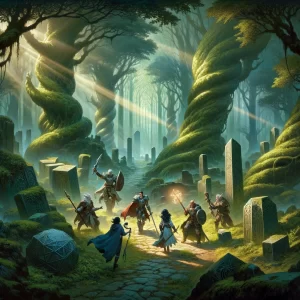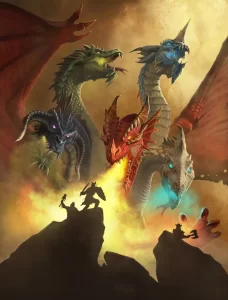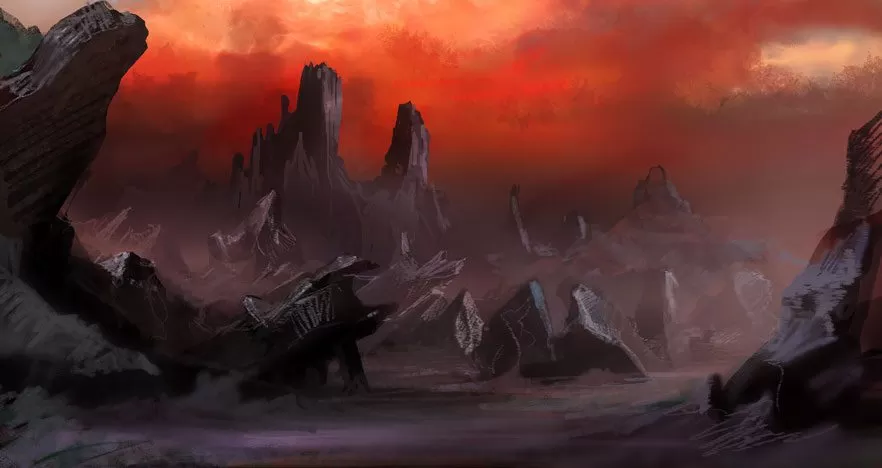
Hell's Planes
In the shadowed and infernal depths of Hells planes, the rulers and denizens are primarily devils, beings of lawful evil that send chills down the spines of mortals. These creatures are bound to a horrifying and unbreakable chain of command, living in constant terror of the arch-devils that hold their fates in their cruel claws. Yet, beneath this rigid order, a macabre dance of rivalry and open hostility plays out among the devils of various planes and the merciless arch-devils themselves.
While the lesser devils engage in savage and bloody squabbles, gnashing teeth and tearing flesh, the dukes of Hell plot and scheme in dark corners, their eyes filled with mad ambition to usurp the throne of the archfiend Asmodeus. This lord of terror, however, has always proven to be a master puppeteer, deftly manipulating and turning them against each other, preserving his reign from the abyss of his lowest plane, where screams and torment echo endlessly.
All devils possess the unholy ability to traverse the planes of Hell, although they dare not do so without proper authorization, except for the dukes, who revel in their dark privileges. These malevolent beings can slip into the planes of Gehenna, Hades, and Acheron at their wicked will, traversing the boundaries of despair and agony. They may also stalk through the Astral Plane, although this is rare, perhaps for reasons too sinister for mortal comprehension.
Entrance
Entrance to other planes is a horror-laden process, locked behind forbidden rituals, gates that creak with the screams of the damned, or the speaking of a devil's name, uttered in whispers and heard with dread. These paths are treacherous, filled with nightmares and despair, and only those who dance with darkness dare tread where devils roam. The name of a devil, once spoken, echoes with a chilling resonance, a summoning from the very bowels of fear itself.
| 1st plane - Avernus | 2nd plane - Dis |
| 3rd plane - Minauros | 4th plane - Phlegethos |
| 5th plane - Stygia | 6th plane - Malbolge |
| 7th plane - Maladomini | 8th plane - Caina |
| 9th plane - Nessus |
It is possible to destroy the material form of a greater devil or duke of Hell, but such creatures cannot actually be slain unless encountered and fought in Hell or those lower planes adjacent to it. Devils can never be subdued. The lesser ones will always fight until destroyed, the greater ones will negotiate if seriously threatened. Devils will serve if properly commanded, but it is risky business. for an improper command will break the law which binds them to service
Some devils, even those of sufficient power to attain archdevil rank (a.k.a. Lord of Nine, or a plane on in the Hells), see their safest position in the present infernal regime to be that of lieutenant to an archdevil. Their precise reasons for this attitude are known only to themselves, but it is thought that some prefer to maintain a low profile so that they can work "behind the scenes," and others prefer to act in the name of an archdevil, thereby disclaiming responsibility for their own actions.
There is certainly some degree of silent cooperation between these servant devils, who wish to avoid being openly set against each other (i.e. in combat) or against any archdevil. This cooperation must be obvious to the archdevils, who seem to tolerate it (Baalzebul the least), and some believe that Asmodeus quietly aids and encourages it, for it adds stability to the present status quo in which he is on top. Fear and/or mindfulness of general strategy (ahead of short-term tactics) prevent most open rivalries between devils from escalating further than exchanges of nasty words and cruel pranks. Bear in mind that most devils are of reasonably high intelligence.

Avernus
Avernus is the first plane of the Nine Hells.
The uppermost plane of the Nine Hells is ruled by Tiamat, the Chromatic Dragon, and serves as a home to all lesser unique devils. These are devils with individual names and characteristics, and powers of greater magnitude than those of a pit fiend (for all such unique devils of lesser power are soon destroyed by their enemies and the cruelty of their fellows), which are not otherwise placed in the hells as ruling archdevils or their direct servants.
There are approximately fifty of these lesser unique devils; embittered, frustrated beings who torment the lemures and spined devils of this plane and viciously attack all intruders. Chief among them is Nergal, who like all of his outcast fellows, plots and schemes constantly to win a higher rank, but through hopes of reward always eagerly and enthusiastically obeys commands issued by the archdevils.
Most such commands concern the defense of the hells against all intruders, for the dukes of hell have no wish to deal with intruders on their own ground - the plane or planes they rule - when such disorderly business can be conducted elsewhere. The uppermost plane of the hells thus serves as a marshalling area and training ground for infernal armies and is (preferably to the devils) the place in which intruders are dealt with.
It is a plane of darkness, consisting of rocky crags and hillocks, a desolate wasteland of stunted, poisonous vegetation and bare rock. Many concealed pits lined with filth-smeared stakes and the like have been prepared for intruders. Avernus has no roads or buildings, but many caves and warrens have been dug out of the rocks; most are devils' homes, as unwary travelers seeking shelter will soon learn.

At irregular intervals the darkness is lit by fireballs that form spontaneously from the vapors of the air, bursting at any height above the ground. If one should notice a glowing, swirling effect in the air, one soon discovers that a fireball will burst in that location one round later. The precise cause of these fiery discharges is unknown, but it is natural and not under the control of any devil or another creature.
Any non-devil lawful evil creatures not native to the hells (such as the occasional beholder), if they are to be found in the infernal regions at all, will be found on Avernus unless specifically located elsewhere by order of an archdevil. One noteworthy example of such creatures are the nycadaemons. These have the power to move freely about the Nine Hells, but they are disliked and distrusted by the archdevils and may well be met with physical opposition if they appear uninvited on a plane other than Avernus.
Avernus is nominally ruled by Tiamat, the Chromatic Dragon. The mother of all evil dragonkind holds Avernus through the support of Asmodeus, but her actual authority extends only as far as her physical reach. Most of the inhabitants of the plane avoid her, not wishing to serve as her meals.
The Chromatic Dragon spends vast majority of her time sprawled in her lair, the great caverns known as Azharul, "The Dragonspawn Pits." Here she is attended by her bodyguards, five huge adult male dragons - one white, one black, one green, one blue, and one red. She is constantly guarded by these consorts, and when not plotting, feeding, enjoying cruel sport or facing danger, Tiamat will be found mating with one of them within a protective ring formed by the other four. She bears litters of up to four dragonets (or "mewlings": very young dragons born conscious and in control of their feeble powers) after an average gestation period of 6 days.
Tiamat occasionally travels via the Astral Plane or Ethereal Plane, perhaps to give birth to a litter on the Prime Material Plane (or Planes, if the multiverse of your campaign includes "parallel worlds") - sometimes grudgingly, at the behest of Asmodeus, but more often to further some plan of her own. The scant remainder of her time is spent roaming Avernus; very rarely, she journeys to the palace of Asmodeus. Those of Tiamat's offspring that are born and remain on Avernus occupy themselves with hunting down and bringing back food for Tiamat and her consorts while the Chromatic Dragon is in her lair.
These offspring/underlings are of all sizes, types, and ages of evil dragonkind, and all are aggressive, cruel, and in good health. Injured, weak, or disobedient specimens are soon eaten by Tiamat, or by others at her direction; she also dines on slain dragons, including slain consorts who have displeased her, and all newborn spawn who are multi-headed or otherwise chromatic in nature. The few of her spawn that survive to achieve "huge adult" status serve as replacements for her consorts.
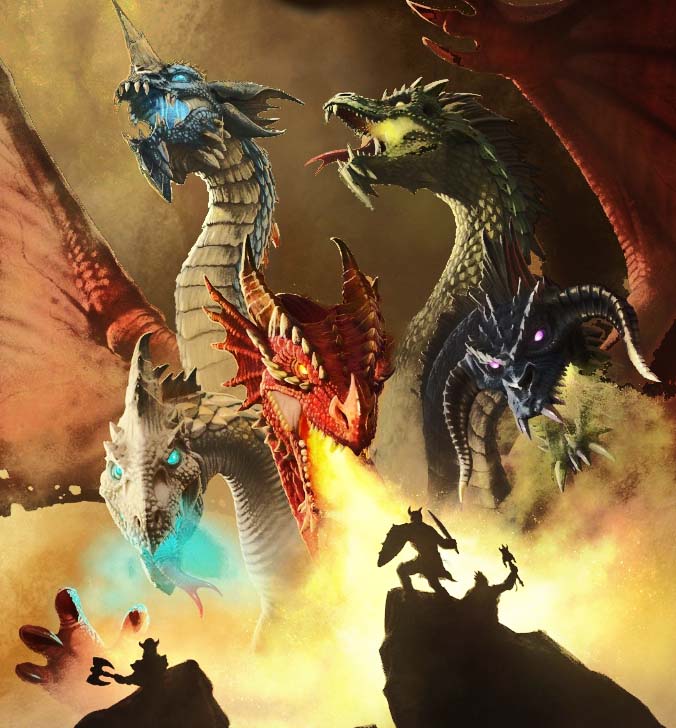
Tiamat will have full amounts of treasure only while in her lair. She may seize small amounts of treasure when on the Prime Material Plane, but only quantities which she can transport herself, since her bodyguards are unable to accompany her when she leaves Avernus. They guard her hoard in Azharul diligently in her absence, for she will notice if even a single bauble is gone! The treasure prized most highly by Tiamat is magic - specifically, Wizard spells of 1st to 5th level which are new to her. With these she can increase her personal power, and consequently she is always seeking more powerful offensive and defensive spells which she can study, experiment with, and modify for her own use.
Although Tiamat will battle (attempting to kill and eat) individual devils without hesitation, she will never knowingly attack an archdevil or a lieutenant to an archdevil. She rules her spawn by force and fear, but her will is enforced on Avernus by 40 companies of abishai under the command of Malphas, 29 similar companies led by Amduscius, and 3 companies of erinyes under the command of the pit fiend Goap.
But Tiamat is just one of in the Nine Hells, and not the most powerful, so she doesn't want to bring too much attention to her lair, else she could find herself as an outcast. Among these outcast devils are names such as Rumjal, Caim, Bist, Cahor, Dagon, Azazel, Armaros, Kochbiel, Nisroch, and Nergal.
Tales are told of a mysterious archdevil, Astaroth, said to be mightier in power than any devil save Asmodeus himself who dwells elsewhere than the Nine Hells, apart from the present regime, working alone to advance his secret ends. This devil represents the greatest threat to Asmodeus; with Astaroth's support, Mephistopheles, Baalzebul, or even a lesser archdevil such as Geryon could conceivably wrest control of the Nine Hells from the Great Devil himself. But even the existence of Astaroth is uncertain; he is definitely not an avowed force in the hells at this time.
Dis
Dis is the second plane of the Nine Hells.
The second plane of the Nine Hells is largely flat, with here and there a bare hill or tor (rock structure) rising smoothly up out of the plains. Its sky is a thick, smoky-hued green without clouds, occasionally lit up by high lightning flickers and faint thunder. The black and cold waters of outward from the moat surrounding the city of Dis, which is the seat of the archdevil Dispater.
The city of Dis, built of unrusting iron, stands on an island in the center of a lake where the rivers meet. The waters are poisoned and give off odiferous (carries) vapors, sometimes visible as smoky wisps or plumes. Over the plains sweep ceaseless, fierce winds, tumbling many lemures helplessly through the air to strike repeatedly against the ground or each other. There is a small chance that a land-based traveler trying to stand or move against the wind will be swept off his or her feet (greater chance if mounted or standing on an exposed position).
Aerial travelers will find the wind unpredictable and savage, so that unless they have spent years learning to maneuver in constantly changing winds, they may lose speed, lose control, else the ability to fly.
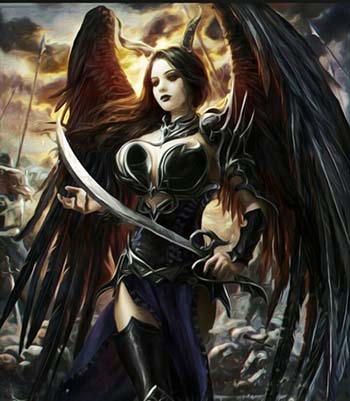
Erinyes, being native to the plane, can navigate with comparative ease in the gale, and some of these devil-types are always aloft, buffeting lemures for sport and watching for intruders. Erinyes earn increased power on the plane of Dis through the favor of Dispater, who rewards them for unswerving loyalty (he often arranges tests or traps for his servants) and for missions diligently and well accomplished. When an erinyes encounters intruders in Dis, it will usually fly near to observe clearly their numbers and appearance, and then head straight for Dis to inform the pit fiend Baalzephon, Dispater himself, or one of Dispater's other commanders.
A lemure arises when a mortal soul is twisted by evil and banished to the Nine Hells for eternity. The lowest type of devil, lemures are repugnant, shapeless creatures doomed to suffer torment until they are promoted to a higher form of devil, most commonly an imp.
Almost certainly the erinyes will encounter others of its kind while on this journey, and these it usually informs in passing of the intruders and their location, so that said intruders will likely suffer attacks from odd bands of erinyes before any organized force is sent out from the Iron City.
If a group of erinyes encounters intruders, all but one - the messenger to Dis will immediately attack. They may not seek to slay the intruders outright, for Dispater, like all archdevils, is always alert for beings or items that can help maintain or improve his own position, and no erinyes deliberately courts his wrath by destroying something Dispater might have liked to have.
The Iron City itself is a dismal place of eyrie-riddled towers, zombies, garbagechoked streets alive with rot grubs (and a black pudding here and there), and ironbarred cells full of chains and torture implements. Abishai, imps, and spined devils, plus occasional barbed devils, hellcats, and rakshasa, throng the dark, reeking streets.
The island on which the city is built rises sharply in elevation toward the center, and on this rocky knob is the "infernally grand" palace of Dispater, many towered and terrible. It is fashioned of stone (unlike the rest of the city) and furnished with iron, carved bone, and stone. Its terraced approaches are adorned with trees fashioned of iron. The palace is off limits to those without a reason for being there.
Erinyes can be seen frequently flitting in and out of the palace's high, arched windows (presumably to give or receive information). There are many caverns beneath the palace, known as "the pits of Dis," where prisoners live in unmanacled savagery, fighting for the edible garbage that falls into their lightless realm down shafts from the palace above.
Minauros
Minauros is the third plane of the Nine Hells.
The third plane of the Nine Hells is ruled by Mammon, the clutching "Lord of Avarice," and nothing of value exists for long on this plane before being destroyed or taken inside the walls of his many-pillared fortress. This nameless abode is built of black stone brought from another plane (possibly the Prime Material), and stands crazily upon great pillars that sink constantly, slowly, into the bottomless ooze of the marsh.
The outlands of Minauros form one great dismal marsh of stinking, rotting earth, covered with carrion and some inches of water. It is a place of eternal rain; dirty water mixed with hail falls ceaselessly, at a steady pace, from the murky, fog-shrouded air. The bodies of a great many creatures lie here; indeed, it is said elsewhere in the hells that Mammon's house is built upon them.
Disease is rampant here; there is a chance of a creature not native to thells contracting a disease and doubles their chances if they imbibe (drink) any of the water on the ground of Minauros, deliberately or inadvertently.
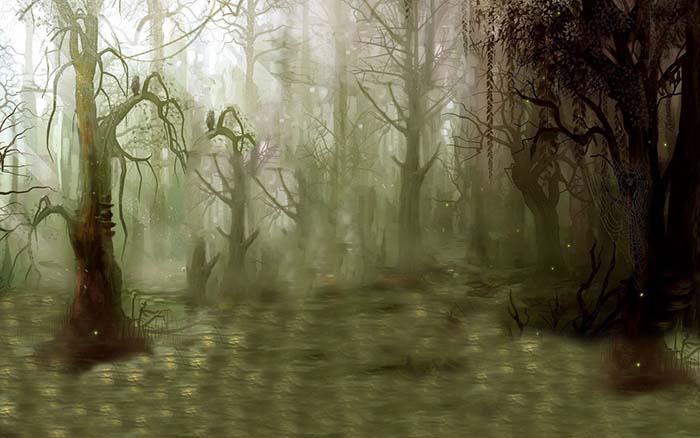
The fortress of Mammon is the only building of any sort on Minauros; in the marshes, Mammon allows stone to be used only in "cells." These are great shallow pits (two or three feet deep in water) in which one or more great stones lie. Fastened to the stones at one end, and dangling away from them, are great chains and manacles of iron or brass. The vigilant barbed devils will capture any intruders and bring them hence, where they sit or stand chained in the cold, fetid water until they die, are taken away for interrogation or torture, or escape.
Sometimes when Mammon or his lieutenants are occupied elsewhere, the barbed devils will let a prisoner "escape" and then hunt it for cruel sport. What they cannot capture they kill, or else call on Focalor, the pit fiend Zimimar, or Mammon himself to deal with.
Typically, barbed devils perch atop the stone of a cell, burning the heads and exposed portions of the prisoners below. Prisoners soon learn (if they survive that long) to sit tight against the rock so that they can use it for protection and support, to elevate themselves out of the water by sitting on a pile of bones, and to keep their heads above water even when sleep comes.
The vassal dukes of Mammon rule stretches of volcanic ridges and ash choked, lifeless woods far from the central palace, between the uplands and the marshes where prisoners lie in dolor. Chief among these vassal dukes is Bael, who can gather 66 companies of barbed devils (and actively plots to supplant Focalor, and ultimately Mammon himself). The duke Caarcrinolaas commands 36 companies of barbed devils, and although he is aware of Bael's ambitions, neither supports nor betrays them. The duke Melchon, who can muster only 18 companies of erinyes, chooses to be eagerly and actively loyal to Mammon - which has earned him the deep suspicion of the seneschal Focalor.
Phlegethos
The fourth plane of the Nine Hells is ruled by Belial. It is a tortured realm of volcanoes, gouting fires, hills of ash, and pits of smoking dung. The ground is always uncomfortably hot - most intruders are constantly on the move - and well patrolled by groups of barbed devils. Ground tremors are common, and a sudden, violent eruption or the opening of a fissure in the earth is not unusual. The sky is a dark, starless void, but the landscape is weirdly lit by leaping flames all about. There are rivers of liquid fire, and at least two large lakes (all the bodies of liquid are interconnected), and there the flames blaze brightest.
This "water" is home to several wandering salamanders that were brought here long ago, to be bound in servitude to Belial. This didn't work out - salamanders take orders from no creature when it does not suit them - and most of the salamanders were immediately slain by Belial's servants and vassals. But a few escaped, yet bound to this plane by Belial's magic, and survive by avoiding large groups of devils and snatching lone creatures who venture too near to one of the rivers of fire.
This plane is perhaps the most visited of the Nine Hells except for Avernus, since outsiders who work magic often come to the fabled "firefalls" of Phlegethos, where the rivers of fire tumble from volcanic ridges down into clefts. The fire in such a spot is mentioned by many alchemists and mages skilled in the creation of magic items.
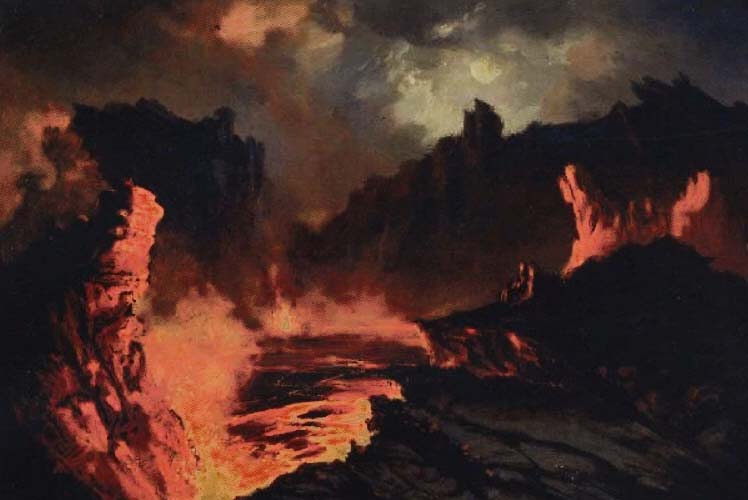
Belial rules from the huge, hollowedout shell of a dead volcano. His stronghold- is known as Abriymoch, "The Mount of Leaping Flames." The archdevil is attended by his consort Naome, his legate Chamo, and a few malebranche. Abriymoch consists of several tiers of chambers, opening into the central shaft like balconies, and connected to each other by stairs, shafts, and a great spiral path that winds about the central gulf or shaft of the dead volcano. Some chambers stretch through the sloping walls of the volcano and have windows or doors opening out onto the volcano's outside flanks. The lips of the volcanic crater are crowned by Abriymoch's basalt towers.
A few erinyes under the command of the pit fiend Zaebos, Belial's lieutenant, serve as messengers within Abriymoch and between it and vassal dukes or outlying patrols. These erinyes are often bullied and are quite miserable, and as usual have their eyes always on bettering their own positions in the hells. Chamo suspects that the erinyes have served as the spies of Asmodeus, Baalzebul, and perhaps other archdevils in the past.
Abriymoch is staffed by spined and bearded devils, and has a kennel of hell hounds that can be used by Zapan's forces to help defend and guard the palace. The vast, smoking plains surrounding the volcanic heart of Phlegethos are the domain of Belial's vassals: Balan, who commands 40 companies of bearded devils; Bathym, who can muster 30 companies of barbed devils; and Gaziel, who leads 11 companies of bone devils. These vassals are usually dealt with and commanded by Zaebos, speaking for his master Belial, who, assisted by Chamo, is usually occupied with matters of diplomacy and intrigue within the Nine Hells.
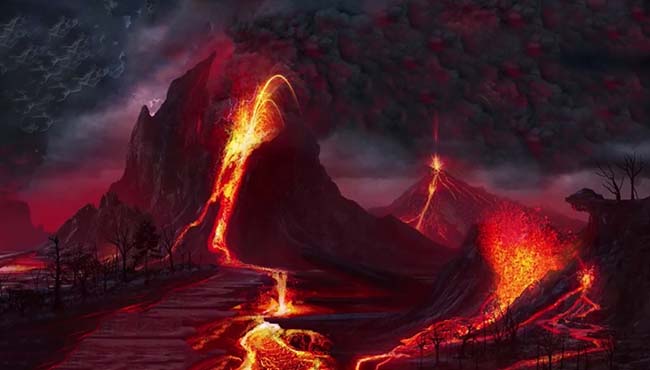
Phlegethos is the most chaotic physical environment in the Nine Hells, affording intruders the most opportunities for concealment - but it is also one of the most active planes, being constantly traveled by its inhabitants. The archdevils of other planes often test underlings by sending them here, charged with accomplishing a task and remaining undetected by the patrols that roam Phlegethos, while their progress is observed by spies - of whom there are many among the barbed devils.
As with Minauros, the outlands of Phlegethos are wetter and lower than the interior, and these "reeking fens" (smelly, flooded, marshy lands) are populated by bearded devils, a few styx devils and abishai, hell hounds, lemures, and the mephits who flit about constantly everywhere on Phlegethos, serving as "eyes" for any and all who reward them.
Stygia
The fifth plane of the Nine Hells derives its name from the Styx, the mighty river of black, opaque water that falls from the endless encircling mountains and swells into a vast salt swamp that fills much of the plane. Stygia is ruled by Geryon from his huge castle, Tantlin, which lies at the center of the plane, the swamp curving about it for slightly less than half the run of its high stone walls. Stygia is a chilly place, lit by lightning flashes and "cold fires" (weird white flames that are freezing cold and do damage while in contact) that burn on rocky peaks for some time after a lightning strike.
It is not known precisely what these flames feed on - they appear to blaze on bare rock - and they leave no trace on rock or ice. Much of Stygia's landscape is high, tumbled rock and ice. Avalanches and electrical storms are common, and "shooting stars" of ice sometimes hurtle across the sky from the peaks, smoking, to plunge into the swamp far below.

The swamp itself is constantly disturbed by splashes and wails, for it is the abode of the styx devils, who torment lemures constantly unless summoned by Geryon to undertake a mission. Sometimes a bone devil or horned devil will enter the swamp to join in the fun, or to chase a few styx devils, but on such occasions all of the styx devils present will eventually unite to drive them out.
Beneath the swamp lies a cold and lightless ocean, home to giant octopi and squids, whales, and many smaller, blind fish. There are no sharks or killer whales, however, for in the utter depths Sekolah, a great white shark, cruises. She long ago devoured all potential rivals, and now swims supreme, ignored by the devils, as the ruler of her deep realm. If there ever was an aquatic race of any sort at the bottom of this black river - sahuagin, diabolic, or otherwise - there is none now.
The sahuagin of the Prime Material Plane worship Sekolah but she appears totally disinterested in all matters except where her next meal is coming from. Much of the upper reaches of the ocean are always frozen (if they were not, much of the vegetation that makes up the swamp would have sunk to the ocean floor long ago), and Sekolah very rarely comes to the surface. When she does, lemures, hell hounds, and devils alike usually make a hasty exit from the surrounding area.
Geryon seldom leaves his great castle. He delights in physically battling lesser devils and captured intruders within the walls of Tantlin, sometimes chasing them for long periods of time throughout the halls of the castle and the gravel-strewn mines nearby, where Tantlin's blocks were and still are quarried, eternally, by captives, spined and barbed devils, and the like.
Geryon delights in luring powerful creatures from other planes (that is, from outside the hells) to Stygia with carefully contrived tales of magic, lore, or other treasure, so that they can be the victims for one of his cruel hunts. Any survivors of these unsporting events go to the quarries. (Geryon, by the way, is immune to the strength-sapping power of the bone devils tail poison.)
One of the most powerful members of Geryon's retinue (assistant advisor) is Herodias, whose title is magistrate. Herodias is responsible for the security of the realm and the training and ordering of Geryon's legions of bone devils, and for assuming command of the defenses of Tantlin whenever Geryon is hunting.
Geryon's bailiff, Gorson, concentrates on external matters. It is Gorson who observes the day- to-day activities and internal politics of the other planes of the Nine Hells, and who (unless Geryon steps in to do this directly) orders and coordinates the styx devils in their individual missions about the planes.
Geryon is perhaps the most satisfied or contented of the archdevils, and the least interested in the endless political struggle among the devils for more power, although he never misses a chance to act to the detriment of his foe Moloch, ruler of the sixth plane, or his other neighbor, Belial. Herodias and Gorson safeguard his interests (under the watchful eye of Cozbi, Geryon's consort), gaining much actual power while always acting in Geryon's name, and allowing Geryon to continue his "hunts" by, if not increasing his force and influence, at least preventing their erosion.
Newcomers to Stygia will find that it is cold (why the swamp and the river Styx do not freeze is a mystery to one accustomed to conditions on the Prime Material Plane), with little shelter outside Tantlin, and there is nothing to eat unless one has a taste for the flesh of devils, lemures or hell hounds. (It is not certain if such flesh is edible by humans. Some mad adventurers in the Realms have boasted of eating the flesh of devils, but the truth of their claims is unknown.
If their words are true, it is impossible to say if such food is poisonous to some, carries any diseases or parasites, or if it in fact has caused their mental conditions.) Tantlin, however, is said to be richly provisioned and furnished, crammed with the bric-a-brac of centuries of plundering the wealth of other planes. (Before he gained the rulership of his own plane, Geryon was wont to undertake extended pillaging expeditions through the Prime Material Plane whenever summoned there by a foolish mortal - and he always sought out the most dangerous, and richest, foes.)
Geryon's vassals are outwardly loyal, and are often called upon to protect their master's interests. They include Amon, who commands 40 companies of bone devils; Agares, who commands 31 companies of bone devils; Machalas, who leads 11 companies of barbed devils; and the pit fiend Fecor, who leads 8 companies of Malebranche ("Evil Claws").
The fiefs of these dukes lie between Tantlin itself and the rockiest heights of the endless, frozen mountains, consisting of rising land and many long, twisting rocky canyons and hanging valleys. There are a few remote volcanic rifts in the mountains, commonly known as "steam trenches," where the Malebranche dwell unless ordered elsewhere.
Malbolge
The sixth plane of the Nine Hells is ruled by Baalzebul through his viceroy (hand of authority) Moloch (Baalzebul's own abode is not on this plane). Moloch is continually ordered about by his lord and watched by the tribune Bileth, for Baalzebul fears that to allow the Grand Duke to rest undisturbed here for long would enable him to somehow wrest control of Malbolge from the Lord of the Flies.
An outsider might well wonder why Moloch would want to rule such a place, for nothing grows in Malbolge. It is a plane of craggy, tumbled black stone and ash, filled with stinking vapors, smokes, fire pits, and huge caves and caverns. The air is always hot and choking, and intruders will find that anything flammable remaining in contact with the ground for more than 30 seconds (such as dry wood, paper, hair, dry cloth, and the like) must save versus (normal) fire or burst into flames. Any such substances that are almost continually in contact with the ground (e.g., the soles of boots) must save at the end of every other turn.
Malbolge is a noisy place, populated by tormented lemures, Malebranche, and occasional spined and styx devils, all of whom suffer at the hands of the cruel Baalzebul (who delights in torture), upon his visits, and the almost equally cruel Moloch. Both delight in the torture and disfigurement of devils, so many of the lesser devils found on this plane will hate them to the point of agreeing to active rebellion (if such an effort seems likely to succeed), and such devils are likely to be missing an arm or leg, or be suffering a similar sort of infirmity, as a result of the amusements of the Grand Duke and his master.
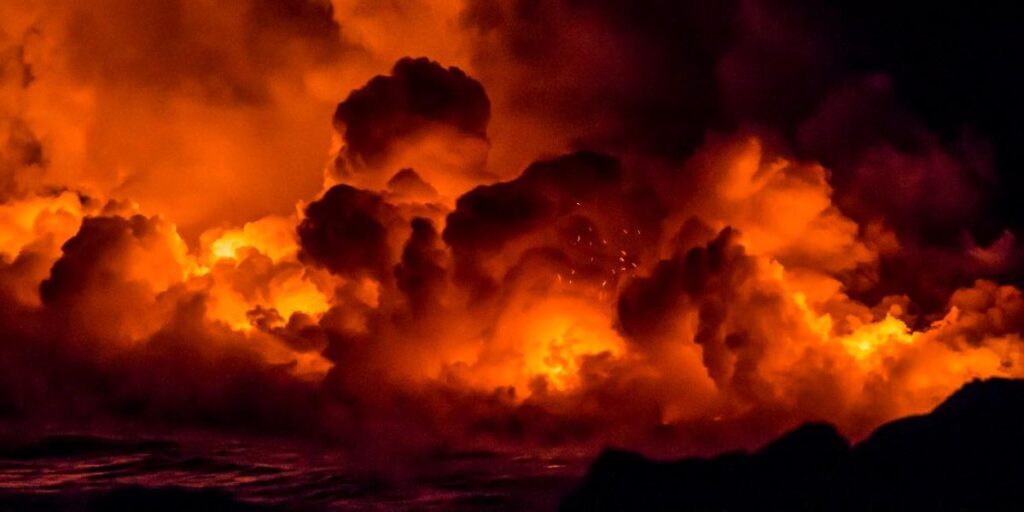
Malbolge is continually patrolled by pairs of Malebranche who report to their commander, the pit fiend Bethage; to the legate Tartach; or to Moloch himself (or to Baalzebul, if the Lord of the Flies is present). Intruders are always brought alive to the horned devils' commander for torment and questioning (or the Malebranche patrol themselves will suffer in the intruders' place). Few intruders escape, and fewer still are allowed to live for any length of time, for Baalzebul jealously grasps and guards all power and knowledge that he can, seeking to keep it from other archdevils (particularly Mephistopheles and Asmodeus), so as to eventually gain the power to rule all of the hells.
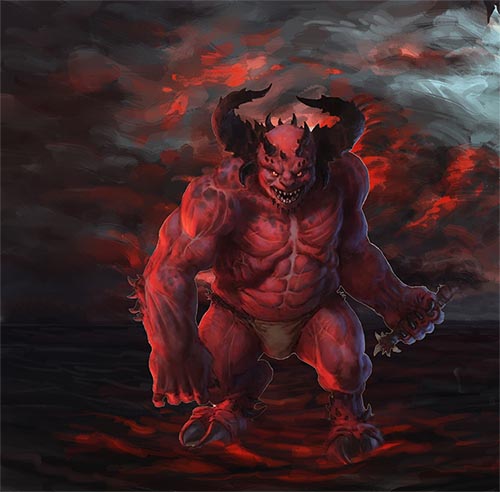
Moloch moves with his consort Lilith from fortress to fortress of the Malebranche upon Baalzebul's orders (usually brought by the herald Neabaz). Tartach is Moloch's deputy and ambassador to the vassal dukes and to visitors, and Bileth is the tribune installed by Baalzebul as a watchdog upon Moloch and others who would take control of the plane.
Baalzebul finds it a continual struggle to retain two planes under his own sway, in a diabolic society where all are ambitious and there are not enough planes to go around. All of the vassals and assistants to Moloch, including Lilith, are regarded as loyal to Baalzebul, although Tartach and Lilith (who feel largely powerless in the current regime) might support a strong bid to seize Malbolge by another arch-devil.
The defensive forces of Malbolge consist of nine companies of Malebranche under the command of the pit fiend Bethage, and sixteen companies of bone devils led by the pit fiend Herobaal.
Maladomini
The seventh plane of the hells is also ruled by Baalzebul, who dwells there in a great fortress of black stone. Baalzebul's fortress, Malagard, sprawls for many miles, and consists of countless black spired towers linked by many open and covered bridge-spans that crisscross and slant crazily in all directions. Here Baalzebul is attended by his consort Baftis, his herald Neabaz, and his marshal Barbatos, plus Malebranche and many lesser devils of all sorts whom he has commanded to service.
Malagard's rooms, passages, and dungeons are so vast and numerous that it is said not even the Lord of the Flies himself has visited all of them. Most of those who escape cells of torment in Malagard flee to the dungeons, seldom penetrated very deeply by the devils, and many weird creatures are said to roam this lightless underworld.
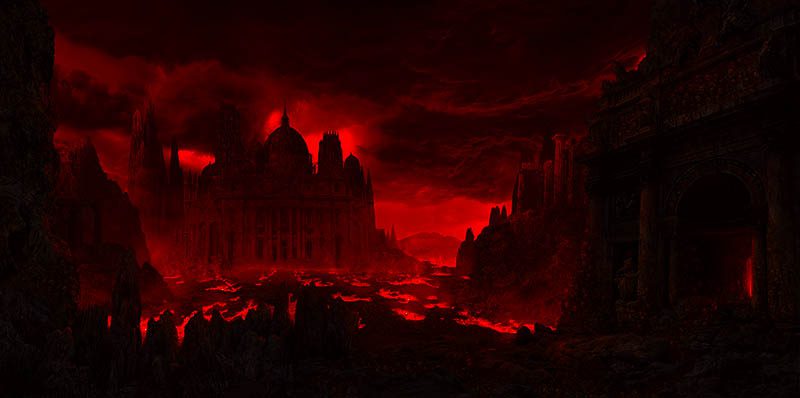
The fortress above contains many rich and sumptuously (splendid and expensive) furnished chambers, many cells for prisoners and for larvae awaiting use, and rooms upon rooms that are choked with garbage. Filth of all sorts, including carrion and anything that is broken and useless (for none of the devils here can be bothered to repair anything) is carried to neglected areas of Malagard by servant spined devils, and tossed into any unused space, so that entire towers of the fortress are crammed with reeking debris.
Outside, the plane of Maladomini is very similar to Malbolge: hot underfoot (see Malbolge, above, for effects on flammable objects) and filled with stinking vapors, earth tremors and underground explosions, fire pits, smokes, and huge caves and caverns.
Maladomini's surface is also despoiled by vast quarries where lesser devils and enslaved prisoners toil ceaselessly to cut the stones from which Malagard and the castles of the Malebranche are built. Roads wind and crisscross the landscape from quarry to quarry to the various castles, and the entire plane is littered with the tumbled ruins of long-ago cities and towers, and the ever-larger new works.
Great arched bridges, carved with diabolic faces, span the rivers of molten lava that cut across Maladomini, and from the river's canals have been cut to carry the liquid fire, so that it encircles every castle of the Malebranche with a moat of leaping flames.
The rivers of lava are swelled by volcanic cascades and eruptions and run in the end to a great sea of lava that seems to encircle the plane. Within this sea are a ring of volcanic mountains, and within this ring lies the confusion of Malagard, Malebranche castles, ruins, roads, and quarries. Baalzebul is said to have vast collections of gems and plants (the latter tended continually by enslaved creatures) in Malagard, but no green things grow in this plane outside Malagard's walls.
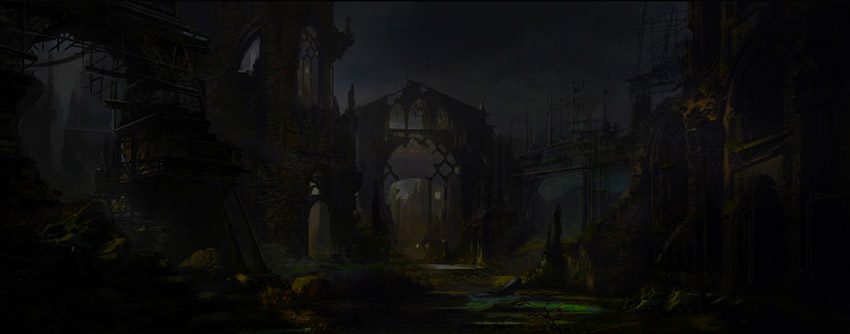
Neabaz (as herald) is the only devil allowed by Baalzebul to move freely about the hells. Barbatos is charged with the duty of arranging malebranche messengers and weaponry so that the armies of Maladomini can be gathered quickly for battle. These malebranche armies - 60 companies under the duke Abigor, and 28 under the duke Zepar - are customarily occupied with the endless construction of Malagard, other fortresses, and linking roads.
Spined devils, typically overseen by styx devils or (rarely) bone devils, feed and tend to the wants of the malebranche laborers. Pit fiends are noticeably absent from Baalzebul's service on Maladomini; the Lord of the Flies suspects all such of being spies for Asmodeus, and is reluctant to allow any of the creatures on the same plane he inhabits.
Caina
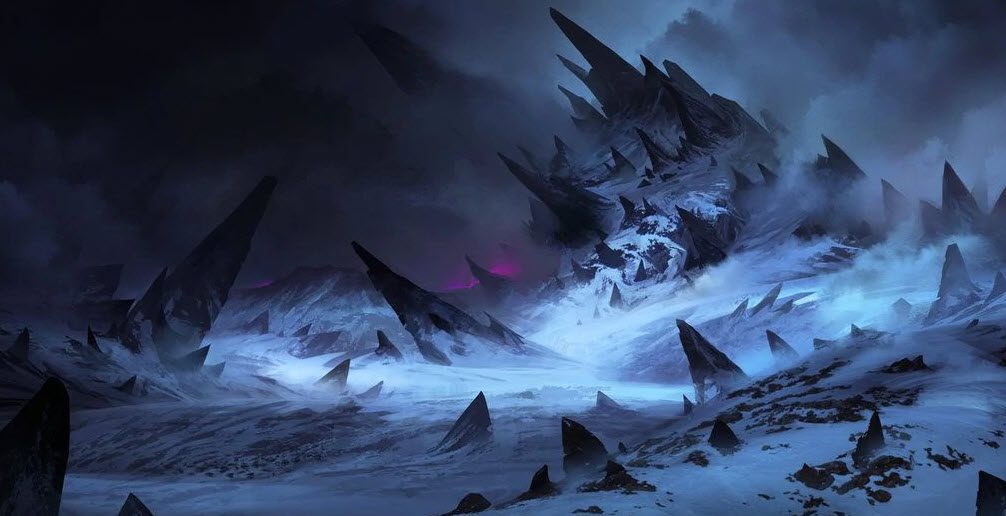
The frigid eighth plane of the hells is ruled by Mephistopheles, the mighty Lord of No Mercy or Cold Lord. This scheming arch-devil rules the frozen wastes of Caina with the help of his consort Baalphegor and his staff: Barbas, chamberlain of Mephistar (Mephistopheles' iron citadel) and guardian of Mephistopheles' wealth and treasures; Adonides, steward of Caina, who oversees the administration and defense of the realm; and Bele, justiciar, who sits in judgement of all disputes within Caina.
Mephistopheles is cunning enough to allow the appearance of justice - and thus win the ease and resulting loyalty of his vassals, as well as reassurance for other devils elsewhere in the Nine Hells who might consider supporting him in a bid to overthrow Asmodeus, showing them that an independent judiciary would be installed under the rule of Mephistopheles, were he to become Overlord of Hell.
Malebranche and spined devils staff the iron citadel of Mephistar, which perches high in the icy mountains at the heart of the plane. Much of Caina is a land of icecovered boulders and mountains, ruins of stone (for it took the devils long to learn that nothing on the glaciers could withstand the inexorable ice), and sprawling glaciers. Bifrons, one of the dukes of Caina, rules from a cold blue palace carved out of the slow-moving ice of a rift in the center of the great glacier Nargus. This glacier is staffed by the ice devils who populate the plane, and by spined devils, who perform the most menial tasks.

Mephistopheles is one of the most careful and suspicious of the arch-devils, and the halls and chambers of Mephistar are patrolled and inhabited by devils in accordance with a strict schedule of activities. Only Bele, Barbas, and Adonides are free of this iron regimentation, and Mephistopheles wants to know where they are and what they are doing at all times. All three devils delight in deceiving their lord as to precisely where they are and what they are doing, but such deceptions are always small things, for they dare go no further in light of the possible punishments.
A visitor will find Caina numbingly cold - without heat, most warm-blooded creatures can only survive for a few hours before suffering chills, later frostbite, and then death. Certainly any such creature that goes to sleep, falls unconscious, or is rendered immobile in the open without heat will die shortly. Ice devils will be immediately attracted to any fire (note that the raw materials for such a blaze will have to be brought by the visitor, since no combustibles are to be found), and will attack without hesitation.
If far from Nargus, an ice devil is not likely to inform Mephistopheles or his staff of the existence of intruders unless there is a chance that other devils have seen them too, and are likely to report them. If a party should escape a lone ice devil, the latter will not warn others of their presence, but will itself remain alert for signs of them.
Were it not for the cold and the lack of food (some tales speak of remorhaz or "glacier worms" in Caina, but if any exist they must be very rare), Caina would offer intruders many inviting places of concealment - there are many hidden valleys in the mountains, and countless icecaves. Corpses, it should be noted, will freeze and be preserved perfectly, so killers of all sorts are advised to seek deep crevasses or snowbanks to conceal such remains.
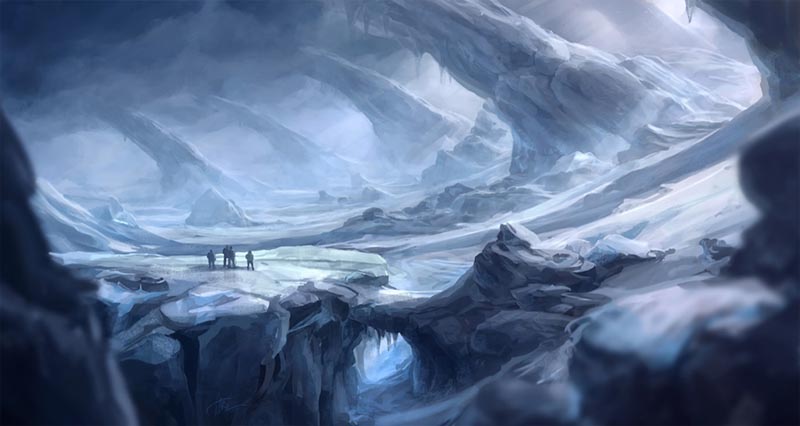
The dukes of Caina are Hutijin, who commands two mighty legions of pit fiends, the nobles of Caina (including Silcharde, Bechard, Guland, Sphandor, and Buldumech); Bifrons, who commands 26 companies of ice devils in Nargus; and Nexroth, who leads 16 companies of malebranche. The pit fiends and malebranche dwell in the rocky spires and pits of the outermost fringes of Caina. These are hot regions crisscrossed by colder, steaming, slimy waters which at length give way to marches of icy ooze which rise at length into the frozen mountains of the plane's interior.
The strength and ambition of the pit fiends (particularly those named above) are a weakness in Mephistopheles' control over his own plane - a weakness encouraged and delighted in by his foes - particularly Baalzebul, who has spies among the Malebranche, and seeks to foster unrest. Only a few of the pit fiends remain strictly loyal to Mephistopheles (without Hutijin, the Cold Lord would soon face open revolt and could not hold the plane). Most seek to gain the most power they can in any change of rulership, and favor dissent and change among the arch-devils as the only way to better their own lot.
None have openly defied Mephistopheles yet, but a time will come . . . unless, of course, Mephistopheles defeats Asmodeus, whereupon their loyalty will be loudly conspicuous. Mephistopheles is openly distrustful of Nexroth, who is totally selfish and loyal only to himself; he will do whatever seems best for his own advancement. Nexroth retains his command only because he seems the most reliable of the pit fiends, and Mephistopheles dares not allow open conflict within Caina for fear that another arch-devil would take advantage of the situation. If not for this, the Cold Lord would cheerfully shift the command whenever it suited him, playing the pit fiends off against one another indefinitely.
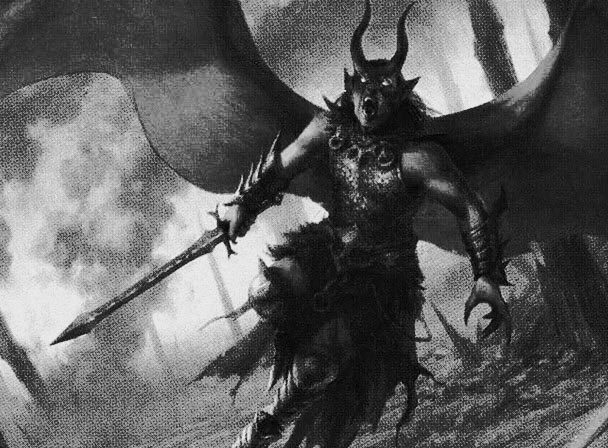
Nessus
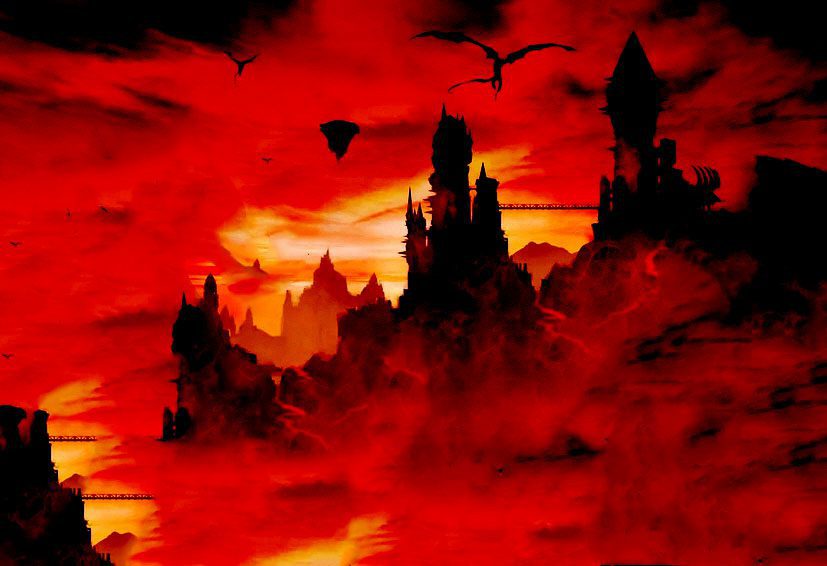
The vast and gloomy ninth and nethermost plane of the hells is known as Nessus, or Cocytus (after the lake therein), and is the personal realm of Asmodeus, Overlord of the hells. Asmodeus inhabits a grand palace, a fey court of darksome beauty, which rests upon the floor of the lowest rift in Nessus. If this abode has a name, it is little used and unknown to men. It is known that smoke rises from its very stones when they are trod by one not of lawful evil alignment, and that Asmodeus has gathered here all objects that he finds beautiful (including much seen as beautiful by man).
It is known that Asmodeus can summon each arch-devil to his court here, once a year, but more details of his palace are few indeed, understandably, since few travelers return whole to the Prime Material Plane after being in the clutches of the Great Devil himself. All manner of beings may be found within its extensive halls, for Asmodeus, a master strategist, makes use of all the powers and talents available in the hells to further his own ends. His bodyguards and personal servants are the mighty pit fiends; outside of the palace, one is more likely to encounter them in Nessus than any other creature, for they are constantly flying here and there at the Overlord's bidding.
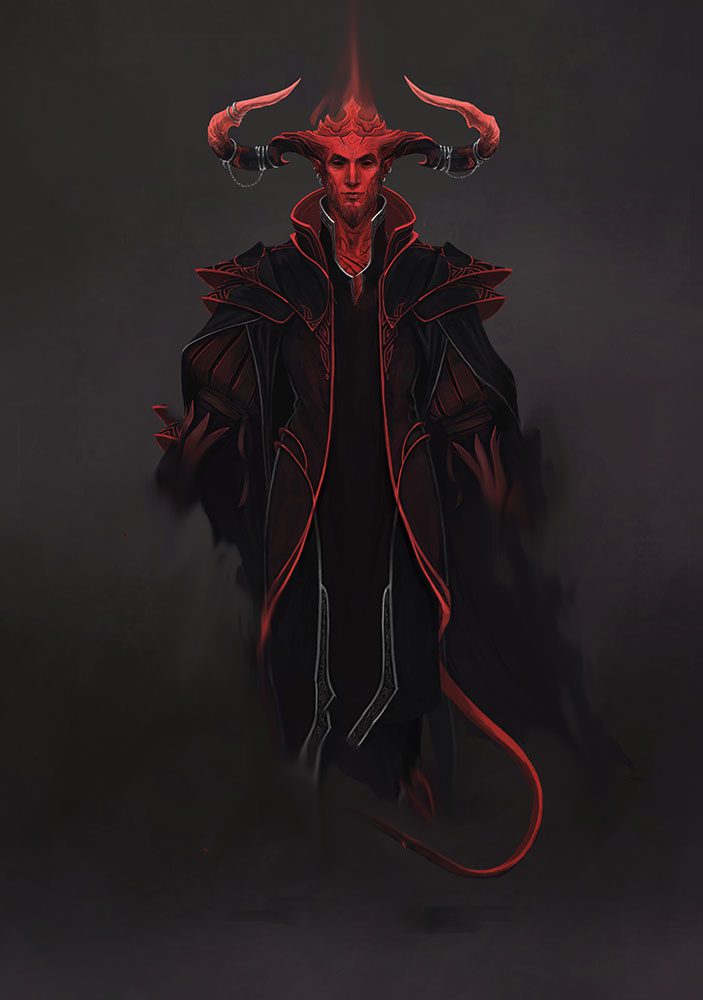
Knowledge of the geography of Nessus is similarly incomplete and possibly inaccurate, but it is known to be a rocky, misty realm that holds many dangers for the unwary.
Lethe, the river of forgetfulness, winds aimlessly about Nessus; no mortal has ever found its source or outflow. All creatures who touch its clear green waters (except devils, who are immune to Lethe's power) must save vs. poison or be permanently feebleminded (only a wish, alter reality, or limited wish will reverse this), and even if cured, victims will lose all memories of the time preceding their cure. Some say that the river Lethe flows through dimensional space in some incomprehensible way, and thereby also flows on the Prime Material Plane. It may thus provide another entry and exit to the deepest plane of the hells - but if any have traveled this route and survived, they do not talk of it.
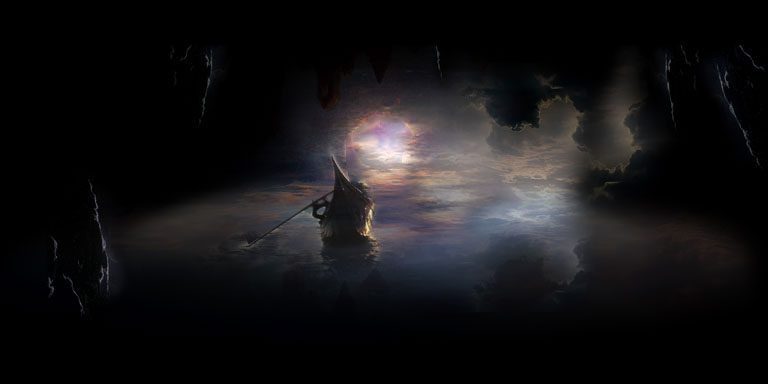
The lake of Cocytus lies far from the palace of the Overlord, high up in a bowl of rock surrounded by crags. It is frozen; a glassy-smooth surface of ice tens of feet thick - and within the ice are trapped the bodies of all who have ever ventured across it, for the ice always rises suddenly, in jaws, to engulf them. A dispel magic or slow will slow this action enough for a creature to escape or be helped clear, in haste, and a wall of force or even a wall of ice will temporarily jam the jaws open and also permit escape.
A shatter spell the physical force wielded by most creatures will not affect the ice, but a crystal brittle spell cast upon it will render the ice fragile (to the extent of the spell's area of effect), subject to the effects of all normal weapons and implements, and a hammer of thunderbolts will shatter it easily (perhaps also damaging a trapped victim). Any magical and/or natural combination of strength equal to a storm giant's (such as the natural might of Asmodeus or Geryon) can affect the ice of Cocytus.
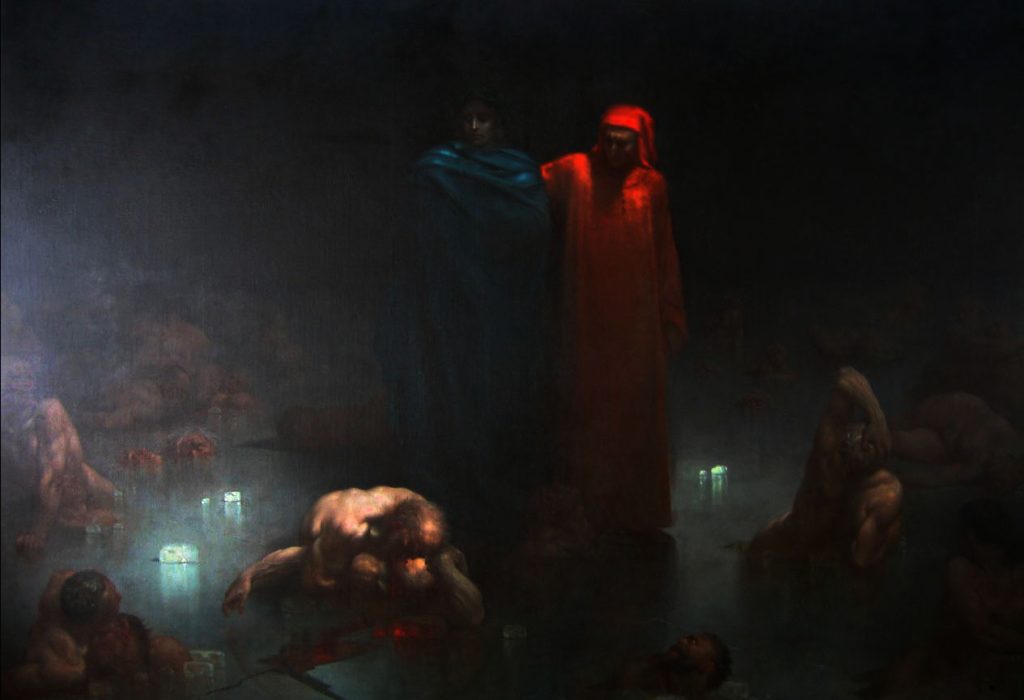
Within the course of the river Lethe is the central area of Nessus, a region of twisted and scorched rock broken by many rifts and knife-edged ridges, and within this area the firewinds sweep. A firewind is a permanent wall of fire (as in the spell) of triple strength and damage, typically up to a quarter of a mile in length, that sweeps over the ground in the forefront of a howling wind (that can inhibit movement). The firewinds blow at random, and may join or break apart in accordance with the topography of the land or for no apparent reason. Usually they will sweep over a creature on the ground in a single round, enveloping it briefly for 4-24 points of damage (save for half damage).
Loose garments, small birds, and so forth may be blown away with the firewind, but in its wake there is relative calm. The bones of many creatures litter this inner desolation of Nessus, and a traveler will find that the rifts grow deeper as one heads inward, so that the bottom of the lowest plane of the hells is a huge bowl or gulf. Here the air is always smoky, and the firewinds howl, and here, at the bottom of the lowest rift (where the firewinds do not reach, but pass overhead) is the infernally grand palace of Asmodeus. Some sages say that in the center of the palace is a great gate that will allow transport from this place to any plane (of the user's choice) in the multiverse.
This gate, they say, will allow passage of any number or amount of creatures and objects, and Asmodeus cannot destroy it or affect its operation. (Devils and other creatures of lawful evil alignment attempting to use it, regardless of power, will be destroyed.) Some believe that the Overlord deliberately built his palace atop it so as to control access to and from the hells; somewhere in the Prime Material Plane, it is hinted, lies the way into the Nine Hells via this gate. The existence of this gate is supported by the legend that to escape the hells, one must descend to the deepest part of the plane. The maker of the gate is unknown, but is probably one or more of the greater gods.

Asmodeus rarely leaves his palace, making his will known and acted upon by servants of apparently unshakeable loyalty. Adramalech serves him as chancellor, recording the numbers, acquisitions, and transformations of the lemures and larvae, torments suffered by devils, the names of those who serve the diabolic on other planes, and the making and terms of all pacts and contracts. The Keeper of the Records answers to no one but the Overlord himself, and has his own tower in the palace, ringed at all times by six pit fiends.
This guard detail is ordered by the pit fiend Baalberith, major domo of the palace, probably at the behest of Asmodeus, and is little liked by Adramalech. A similar guard rings the chamber or person of Bensozia, consort to Asmodeus, at all times. Another 54 pit fiends round out the palace guard. Phongor is the most feared devil in Nessus, after Asmodeus himself; he serves Asmodeus as inquisitor, and little information escapes his probing questions and methods of persuasion.
The greatest pit fiend of all, the awesomely scarred, broken-winged Alastor, serves Asmodeus as executioner. His strength is that of a storm giant's, and he never speaks. It is said in the hells that if all were swept away, and Asmodeus could choose but one devil as a companion, that one would be neither consort nor lieutenant, but Alastor the Grim.
Another pit fiend, Martinet, is constable of Nessus, responsible for the personal armies of Asmodeus. These armies camp eternally around the palace, and their generals confer often with the Overlord. These proud dukes are: Buer, who commands 15 companies of pit fiends; Morax, leader of nine such companies; Bune, general of 30 companies of malebranche; Rimmon, head of five companies of ice devils; and Zagum, leader of 30 companies of barbed devils.
It is said that the nycadaemon, Daerith, once appeared unannounced over the lake of Cocytus and flew toward the palace of Asmodeus, and before it reached the crags about the lake was destroyed utterly, torn apart bodily by pit fiends on patrol. With such guardians, it is small wonder why the mysteries of the plane are so many, and the visitors who return whence they came so few.
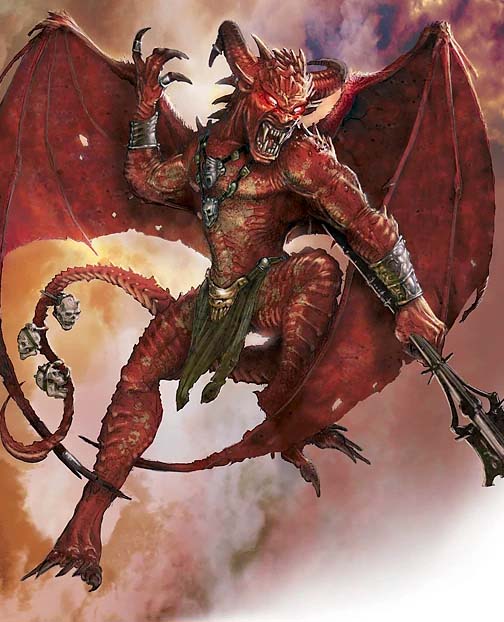
Read about the birth of Hell and the Abyss.




